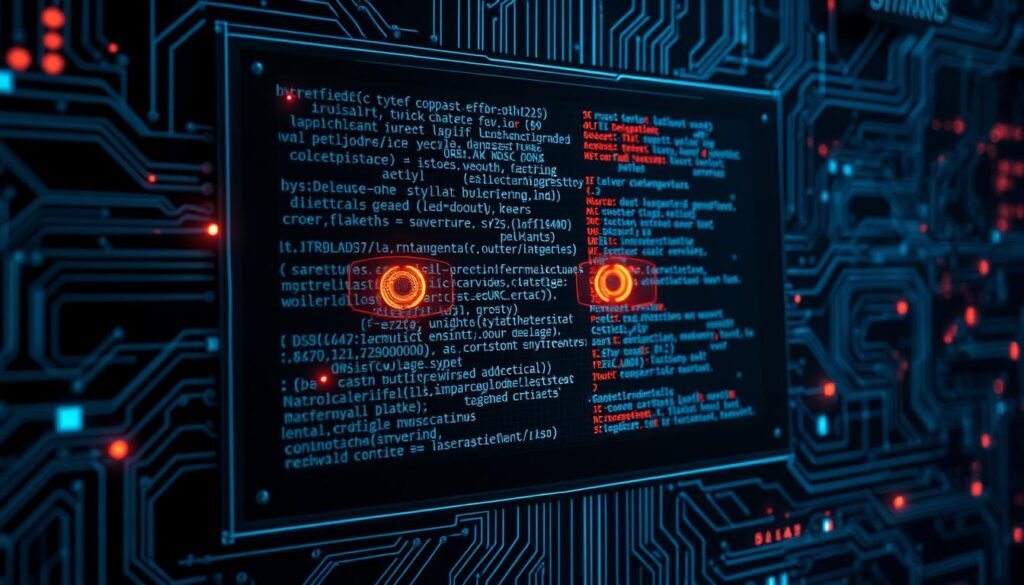Is your digital life an open book? In today’s world, spyware technology is a silent threat. It hides in our devices’ shadows. It affects everything from our privacy to national security.
The story of Hvaldimir, a 15-year-old beluga whale, shows how surveillance tools are evolving. Found near Norway in 2019, it wore a camera harness. This raised questions about Russia’s possible underwater spying.
As cyber threats get more complex, knowing about spyware is key. This software can sneak into systems without being noticed. It risks your data privacy and can lead to identity theft or corporate espionage.
In a world where digital info is powerful, learning about spyware is vital. Let’s explore digital surveillance together. We’ll look at how to protect yourself in this changing world.
Understanding the Basics of Spyware Technology
Spyware is a type of malicious software that watches over you without you knowing. It secretly collects information without asking you first. This can happen through different ways, putting your personal and work security at risk.
Definition and Purpose of Spyware
Spyware is made to collect data without anyone noticing. It can be used for many things, like watching someone or gathering lots of information. Criminals use it to make money or for political reasons.
Common Types of Spyware
There are many kinds of spyware out there. Keyloggers record everything you type, including passwords. Adware watches what you do online to show you ads. Trojan horses pretend to be safe software but really get into your system.
How Spyware Infiltrates Systems
Spyware can get into your system in several ways. It might come from emails, bad websites, or old software with holes in it. Some spyware tricks you into downloading it with fake updates or pop-ups.
The Evolution of Spyware in Cybersecurity Threats
Spyware has grown from simple tracking tools to complex systems. This change is a big deal for cybersecurity. Now, with the rise of IoT devices, spyware can track more than just computers and phones.
There’s been a big jump in complex attacks lately. The Cicada3301 ransomware has hit 23 victims since mid-June. It can attack both Windows and Linux systems, showing how widespread spyware has become.
As spyware gets better, so does the threat to our privacy. The SlowTempest campaign used phishing emails to target Chinese-speaking users for over two weeks. This shows how persistent spyware threats can be.
Our online safety is at risk from these new threats. Spyware now uses AI to collect and analyze data better. This makes it harder to detect and puts our personal info at risk. We need to keep up with spyware technology to stay safe online.
Recognizing Signs of Spyware Infection
Spotting spyware on your device is crucial for keeping your online world safe. It’s important to know what signs to look for to avoid privacy issues. Let’s look at some key signs that might show your system has spyware.
Performance Issues and Unusual System Behavior
If your device starts to slow down or acts odd, it could be spyware. This malware uses up your system’s resources, leading to lag and crashes. You might also see your battery draining quickly or your device getting hotter for no reason. These signs are warning you something’s wrong.
Unexplained Data Usage and Network Activity
Watch your data usage closely. Spyware sends data back to its creators, which can increase your data use. If you see strange network activity when you’re not using your device, it’s a clue. This could mean spyware is running in the background.
Changes in Browser Settings and Homepage
Regularly check your browser settings. Spyware often changes your homepage or adds unwanted toolbars. If you see unfamiliar search engines or pop-ups, your browser might be at risk. These changes are not just annoying – they’re also security threats.
Early detection is key in fighting spyware. By being alert to these signs, you can keep your personal info safe and maintain your digital privacy. Regular scans with trusted antivirus software can catch spyware early.
Spyware Technology: Advanced Techniques and Capabilities
Spyware technology has grown into a complex set of surveillance tools. These tools can secretly monitor individuals and organizations. They use advanced methods that make it hard to detect and remove them.
Rootkit technology is one such method. It helps malicious processes hide from detection software. This lets spyware stay hidden for a long time. In a recent case, attackers went unnoticed in systems for over two weeks using this method.
Modern spyware does more than just collect data. It can take screenshots, record audio and video, and even tap into encrypted chats. Some spyware targets certain groups through phishing emails. For example, a recent attack on Chinese-speaking users sent Cobalt Strike payloads via emails with zip files.
Tools backed by governments show the top level of spyware sophistication. These tools use several malware pieces to gain persistent access and move through networks. The complexity of these attacks shows how important strong cybersecurity is for everyone.
The Impact of Spyware on Data Privacy and Personal Security
Spyware is a big threat to our privacy and security. It can sneak into our devices, causing big problems for both people and businesses. The harm goes beyond just being a nuisance, often leading to serious money and mental health issues.
Identity Theft and Financial Risks
Spyware is a major cause of identity theft. Criminals use stolen info to commit fraud, open credit lines, or buy things without permission. A study by Khormali et al. (2018) showed that in-browser cryptojacking, a type of spyware, is getting more advanced. This puts our financial details at risk.
Corporate Espionage and Intellectual Property Theft
Businesses face threats from spyware too. Hackers can take sensitive info, secrets, and ideas, leading to big financial losses. Bansal et al. (2016) pointed out how cloud computing can be a weak spot for spyware attacks. This shows we need strong ways to fight cybercrime in the workplace.
Psychological Effects of Privacy Invasion
Being spied on by spyware can really mess with our minds. People feel stressed, anxious, and don’t trust technology as much. A survey by Barona and Anita (2017) showed that data breaches, often caused by spyware, have lasting effects on people and companies.
As spyware gets more advanced, we need to keep up with our defenses. It’s important to stay informed and use strong security tools to protect against spyware attacks.
Cutting-Edge Anti-Spyware Protection Methods
The fight against cyber threats is getting more complex. Now, anti-spyware uses artificial intelligence and machine learning to fight infections. These smart systems look for patterns and behaviors to spot threats early.
Advanced firewalls are key to keeping the Internet safe. They watch over network traffic and stop suspicious actions. It’s also vital to keep software updated, as updates fix holes that spyware could use.
Multi-factor authentication adds an extra security layer to your online accounts. It asks for more than just a password to get in. This makes it much harder for hackers to break in, even if they have your password.
New technologies are bringing new ways to fight spyware. Blockchain can spread data across many places, making it hard to change. Quantum encryption is still new but could make codes so strong that hackers can’t break them.
As spyware gets smarter, we need to stay ahead in cybersecurity. Using these new methods can greatly improve your online safety. It helps protect your digital life from new threats.
Legal and Ethical Considerations in Spyware Use
The use of spyware raises complex legal and ethical questions. Governments, companies, and individuals must balance security with data privacy. This issue is getting more attention as surveillance tools get better.
Government Surveillance and National Security
Governments use spyware for national security. The case of arrests in France shows how complex this issue is. Leaders like Macron use secure platforms like Telegram, showing the need for safe communication.
Corporate Monitoring and Employee Privacy
Companies struggle with using spyware on employee devices. France’s strict actions against executives show how serious data privacy is taken. The line between security and privacy invasion is often unclear at work.
International Laws and Regulations
Laws like Europe’s GDPR protect privacy in the digital world. The push for blockchain-encrypted messaging shows how privacy tech is evolving. As spyware gets better, international laws are having trouble keeping up.
Real-World Examples of Spyware Attacks and Their Consequences
Spyware attacks are a big threat to our online privacy and security. The Pegasus software, made by NSO Group, is a key example. It targeted journalists and activists around the globe, sparking worries about privacy and tech misuse.
In 2020, the SolarWinds hack showed how deep spyware attacks can go. It hit many organizations and government groups, showing we need strong ways to fight cybercrime. The hack leaked important data and showed weaknesses in common software.
These attacks have big consequences. By 2023, the average cost of a data breach hit $4.45 million, up 15% from before. Phishing attacks, often used to spread spyware, caused 36% of all data breaches in 2022. These facts highlight how vital it is to protect our data in today’s connected world.
The Future of Spyware and Cybersecurity: Trends and Predictions
The world of cybersecurity threats is changing fast. As technology gets better, spyware makers find new ways to use our weaknesses. Artificial intelligence will be a big part of the future of spyware. AI will make surveillance tools better at gathering information.
5G networks and Internet of Things devices bring new chances for spyware. They give us faster connections and more devices connected to the internet. But, they also make it easier for hackers to find new ways to attack. Keeping the internet safe will be more important as our homes and cities get smarter.
Quantum computing is a big change coming our way. It could change how spyware works and how we protect ourselves. We might see a race in digital security as both sides try to stay ahead. The future of cybersecurity will be all about constant innovation to keep up with new threats.
As these changes happen, we all need to be more careful. Keeping software updated, using strong passwords, and being careful online will still be key to staying safe. The future of cybersecurity will ask us to be more aware and proactive in protecting our online lives.
Protecting Yourself: Best Practices for Avoiding Spyware Infections
In today’s digital world, keeping your devices safe from spyware is key. With ransomware attacks happening every 11 seconds, and the average cost of a data breach hitting $4.45 million in 2023, staying safe online is crucial. Threats like Cicada3301, which targets Windows and Linux systems, show we must be careful.
To keep safe, start by using strong, unique passwords. Sadly, “123456” was used by over 103 million people in 2022, making it a hacker’s favorite. Always update your software to fix security holes. Be careful with attachments and links, as phishing attacks led to 36% of data breaches in 2022.
Using a virtual private network (VPN) can boost your online safety. This is vital, as 35% of attacks in 2022 were Man-in-the-Middle attacks. Backing up your data and watching your account activity are also important steps. By doing these things, you can fight against spyware and other threats better.


